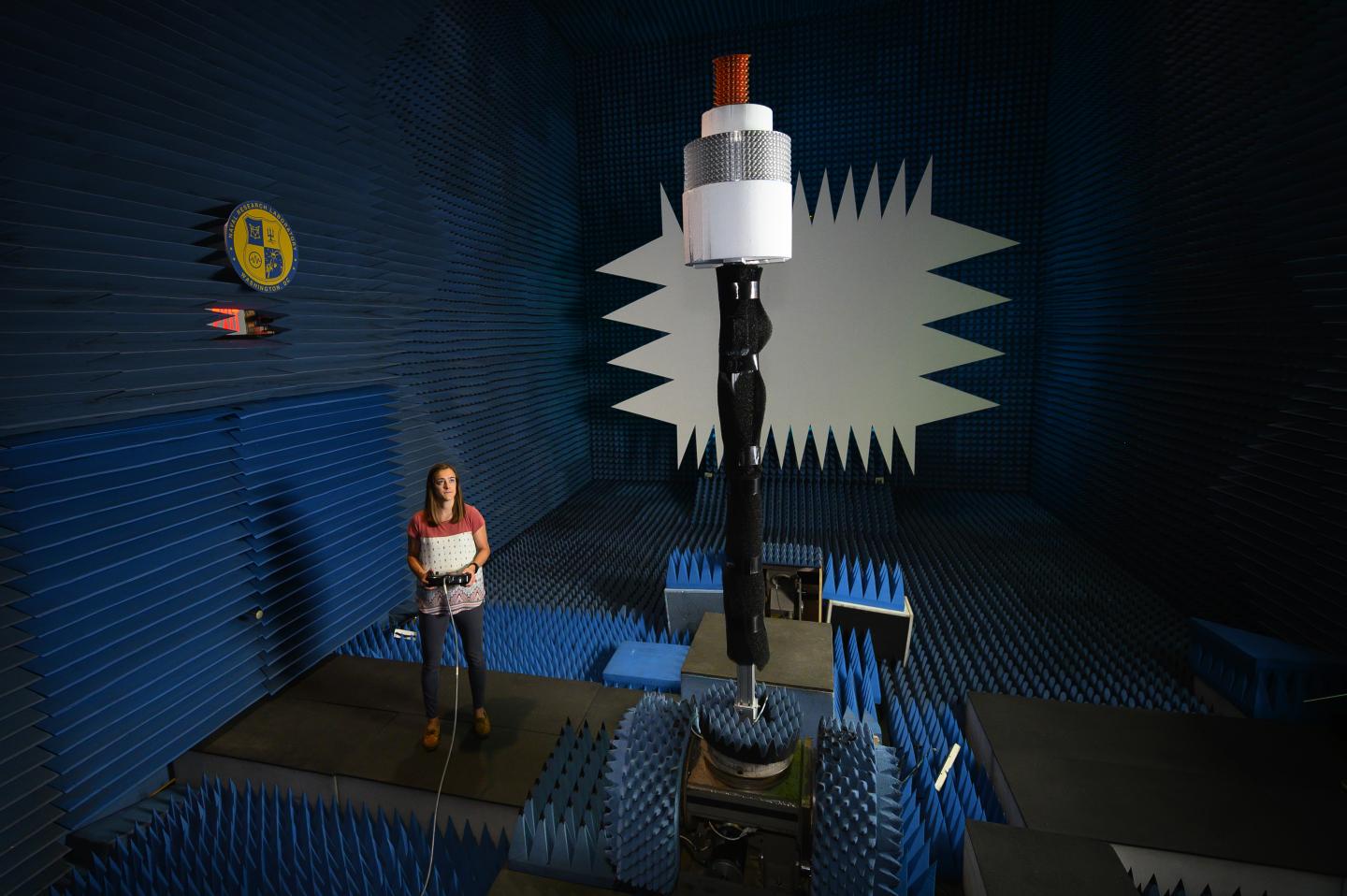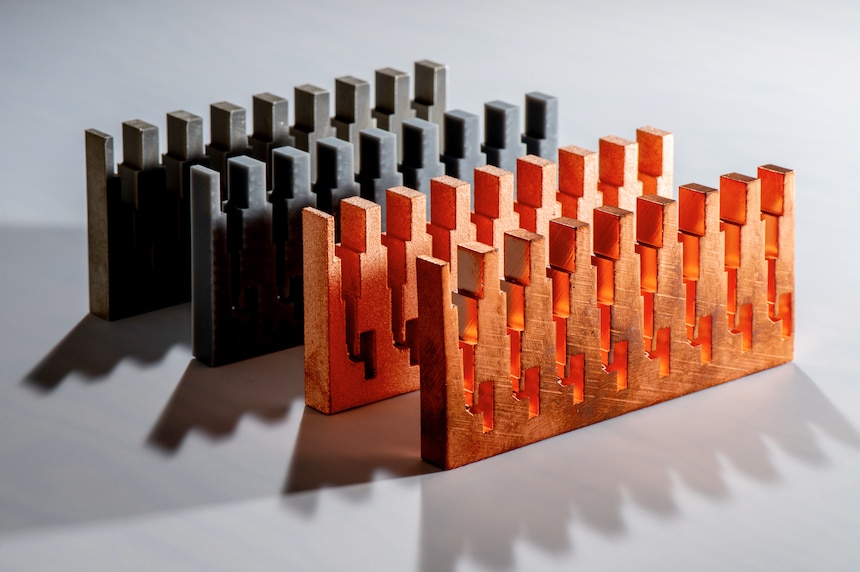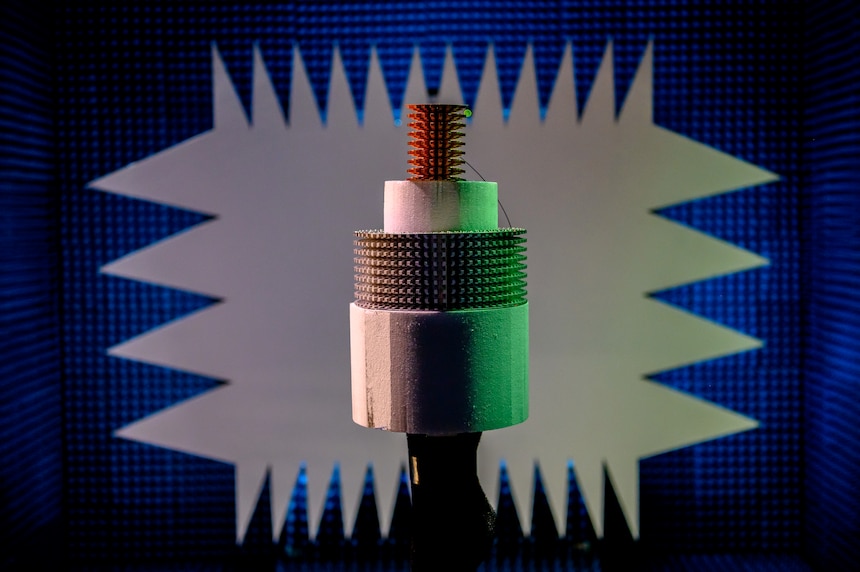As Executive Editor Joris Peels recently pointed out, antennas are one of those killer apps for which 3D printing is perfect. With the ability to create unique geometries capable of more powerful, yet smaller devices, 3D printing is already being explored for such an application, though more often privately than publicly. Now, the U.S. Naval Research Laboratory (NRL) has announced the creation of 3D printed antennas and arrays for the improvement of radar technology and new naval applications.
NRL electrical engineer Anna Stumme picked up on the speed and material benefits offered by 3D printing, saying, “3D printing is a way to produce rapid prototypes and get through multiple design iterations very quickly, with minimal cost. The light weight of the printed parts also allows us to take technology to new applications, where the heavy weight of solid metal parts used to restrict us.”

Anna Stumme, U.S. Naval Research Laboratory electrical engineer makes adjustments to an array inside the anechoic chamber at the U.S. Naval Research Laboratory in Washington, D.C., Sep. 5, 2019. Stumme creates and tests prototype parts developed using traditional and 3D printed methods. (Photo by U.S. Navy photo by Jonathan Steffen)
Prototyping is another application where the design of new antennas shines, as it allows the NRL team to iterate different versions quickly before settling on a final schematic.
“We are not trying to say we need to 3D print everything and put it on a ship because that is not realistic,” Stumme said. “We don’t necessarily know how it would hold up in that environment. For us, it’s a way to test more design iterations in a short amount of time.”
Prototyping is obviously a use that the 3D printing industry as known since the technology was developed in the 1980s; however, the NRL team takes testing a step further than form and fit. After 3D printing designs using nylon, an antenna can be electroplated with metal, allowing them to examine the device’s surface roughness.
“Surface roughness is important for wave guides and antennas because it can cause scattering losses and result in a less efficient antenna,” said Nick Charipar, head of the Applied Materials and Systems Section. “Antennas radiate and receive waves. So if a wave runs along a rough surface it is distorted and the energy may not go where you want it to go.”

Manufactured column element parts of cylindrical arrays used for testing the viability of additive manufacturing to make cylindrical arrays at the U.S. Naval Research Laboratory, Washington, D.C., Sep. 5, 2019. From left to right: metal 3D print, stereo lithography (SLA) print, selective laser sintering (SLS) Nylon print with electroplating, and SLA print with electroplating. (Photo by U.S. Navy photo by Jonathan Steffen)
Charipar’s team within the NRL’s Material Science & Technology Division also examines the relationship between the material of the prototype parts and the functionality of the radar. If it’s possible to determine the proper parameters for 3D printing certain components, it’s possible that on-board 3D printing could be used to replace spare parts.
One potential advantage the NRL sees with 3D printing is the ability to replace broken antenna parts quickly. This includes a cylindrical array, which allows for 360-degree visibility. Another application may be the production of unique antennas for environments where weight and size are an issue, such as unmanned aerial vehicles or small ships.

Two arrays await testing in the compact range at the U.S. Naval Research Laboratory, Washington, D.C., Sep. 5, 2019. The two white parts are Styrofoam supports—between the Styrofoam is an array built using traditional machining methods (all metal cylindrical array). On top is a 3D printed sector array. A similar setup with be tested before the end of 2020 to compare the performance of traditionally manufactured parts against 3D printed parts. (Photo by U.S. Navy photo by Jonathan Steffen)
This year, Stumme and her team aim to test new cylindrical array apertures for an X-band surveillance radar in the lab. The device is meant to examine the location directly surrounding a ship. It may be possible to directly integrate cylindrical arrays into the masts of smaller ships by leveraging microwave photonics and optical fibers.
“Cylindrical arrays are advantageous because they provide full 360-degree visibility,” said Mark Dorsey, head of the Antenna Section in the Radar Analysis Branch of the Radar Division and project principal investigator. “Optical fibers are valuable because they can allow for long separations between the antenna itself and where the processing is conducted.”
Optical fibers make it possible to minimize the number of pieces within a ship’s mast, thus cutting heat and weight constraints. Stumme will be testing 3D printed versions of the array as compared to conventional arrays, with field testing scheduled for this year.
As stated above, this is only one example of a public project in which the 3D printing of antennas is being tested. We also know that Lite-On Mobile uses Aerosol Jet technology to 3D print antennas directly onto consumer electronic devices. Back when it was focused on electronics 3D printing, Voxel8 worked with the MITRE Corporation to 3D print new antenna designs, as well. Joris discusses a number of other use cases in his post and this author is somewhat convinced that the CIA, via In-Q-Tel, is up to something using Voxel8’s technology, too.
Subscribe to Our Email Newsletter
Stay up-to-date on all the latest news from the 3D printing industry and receive information and offers from third party vendors.
You May Also Like
Gorilla Sports GE’s First 3D Printed Titanium Cast
How do you help a gorilla with a broken arm? Sounds like the start of a bad joke a zookeeper might tell, but it’s an actual dilemma recently faced by...
Nylon 3D Printed Parts Made More Functional with Coatings & Colors
Parts 3D printed from polyamide (PA, Nylon) 12 using powder bed fusion (PBF) are a mainstay in the additive manufacturing (AM) industry. While post-finishing processes have improved the porosity of...
$25M to Back Sintavia’s Largest Expansion of Metal 3D Printing Capacity Since 2019
Sintavia, the digital manufacturing company specializing in mission-critical parts for strategic sectors, announced a $25 million investment to increase its production capacity, the largest expansion to its operations since 2019....
Velo3D Initiates Public Offering in a Bid to Strengthen Financial Foundations and Drive Future Growth
Velo3D (NYSE: VLD) has been among a number of publicly traded 3D printing firms that have attempted to weather the current macroeconomic climate. After posting a challenging financial report for 2023,...































